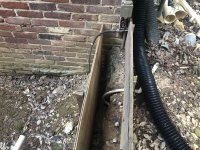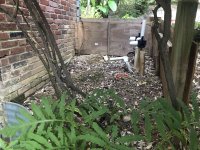Good morning everyone - I hope you're all enjoying a great weekend.
I'm excited, and somewhat anxious about a big pool renovation job I am doing. I previously cut out and donated all of the existing pool equipment at this house, leaving only the 2" plumbing stub-outs above grade. The original installation was really weird. Inside a rusty and leaky tin shed, the installers had cut out the (mostly rotted) wooden floor and installed everything BELOW the floor line. I suspect the installer/homeowner(?) was fixated on ensuring that the pump suction inlet was below the fill level of the pool, which they had accomplished.... er, at a significant cost in other functional areas!
With the shed and all gear demolished, I'm left with a 'pit', and to make matters more complicated, this below-grade area is on a significant slope, and represents a path for water to travel past the house (I already have laid in some French drains skirting this area, to intercept and divert as much run-off as possible). I have a generously-sized new Hayward cartridge filter, new Hayward variable speed pump unit, and Hayward controller. (I was patient, and able to find all of these new-in-box, but with a significant associated discount on each item). The only thing left is to buy a salt-cell and replacement Sched 40 fittings to put everything together.
The dilemma - I think I am facing a concrete pour project that requires forms both horizontally and vertically. I would at this point turn this over to the pros, but I just can't wait for any of them to be avail. Their schedule at this time of the year makes me envious - I would have LOVED to have had that much work avail to me in my profession!
I'm attaching pictures. I need to accomplish a typical pad for the equipment - to provide a base extending outwards from the house outside wall, and coming across to near where the pipework comes above grade. I am looking at aprox 48" out from the wall, and can go as far as 60"+ lengthwise, parallel to the house wall. During heavy rain, water will run downslope, parallel to the direction of this outside wall. At the same time, I will want to build a 'curb' that goes above grade by a few inches - say 4" tall - on at least 2 sides, to make sure that running water is deflected around the equipment area.
Ignore the existing forms in the pictures - that was my first amateur attempt in 2023, using scrap lumber. I'm tearing it all out today. It was destined to fail as soon as wet concrete mix starting going in. I am going to pickup 2 x 6's for the new forms. I will also start bringing up the overall level of the pit, moving avail soil from elsewhere in our yard. And as I build up the overall grade, I plan to slip some 12" extensions and protection on all of the existing vertical 2" Sched 40 stub-outs.
I cannot find any demonstration videos online that would demonstrate how to do this concrete work. Does anyone know if the pour should be done in one, or 2 stages? Ie - pour pad, then remove these forms, and form up and pour vertical curbs? Or build forms that enable both to be done at the same time? Ideally, the work flow would be set so that the 2 concrete bodies still had a good opportunity to bond well (the water incursion issue). I would appreciate any thought on this. Plus anything you might be able to think of. I am stumped by vertical-plus-horizontal concrete, and doing this on what might be a 20-25% slope. (I'm sure a concrete pro would work this out in 30 seconds)
One last thing - at the risk of putting too much into this post - during clearing of the site, I retrieved (amongst other random materials) 3 x significant concrete slab pieces. They're shown here. It's a struggle to move them myself, but I can. Two of these are 36" x 36", and one is 23" x 36". They're all different thicknesses, but within a ½" of each other 1 7/8" - 2 1/4". Is it feasible to grade the site, then lay out 2 of these, and make a curb around them? I just cannot tell if pieces laid in like this are stable enough to avoid problems in the future. (thinking ahead mostly to the weight of the loaded filter, and any vibration from a running pump unit).
A side issue - Electrical service needs to be run again (what they did was wildly crappy and dangerous!). Electrical comes through the house wall near the top corner. I will eventually re-run a dedicated 240 volt service from the panel inside the house, but for now I can bring the new Hayward equipment online by repairing the 120 volt service that is in place. (this Hayward gear can work in 120 or 240 volt mode). I think I can go ahead and form my concrete up without needing to take account of the electrical work that will need to be done.
If I am in a rut with my thinking here, please let me know. That's the trouble working alone - you don't have 2nd eyes-plus-brain to call out "WAIT a minute there, Sparky!" Our neighbour Mike would have been great for this, and I miss his companionship 'across the fence' - but his cancer has now progressed to a point where he doesn't answer my texts, and does not want to see me anymore. It's a big loss.
Thanks in advance for your ideas. I will start breaking down the toy forms, and hauling dirt..... another honest start to my weekend!
I'm excited, and somewhat anxious about a big pool renovation job I am doing. I previously cut out and donated all of the existing pool equipment at this house, leaving only the 2" plumbing stub-outs above grade. The original installation was really weird. Inside a rusty and leaky tin shed, the installers had cut out the (mostly rotted) wooden floor and installed everything BELOW the floor line. I suspect the installer/homeowner(?) was fixated on ensuring that the pump suction inlet was below the fill level of the pool, which they had accomplished.... er, at a significant cost in other functional areas!
With the shed and all gear demolished, I'm left with a 'pit', and to make matters more complicated, this below-grade area is on a significant slope, and represents a path for water to travel past the house (I already have laid in some French drains skirting this area, to intercept and divert as much run-off as possible). I have a generously-sized new Hayward cartridge filter, new Hayward variable speed pump unit, and Hayward controller. (I was patient, and able to find all of these new-in-box, but with a significant associated discount on each item). The only thing left is to buy a salt-cell and replacement Sched 40 fittings to put everything together.
The dilemma - I think I am facing a concrete pour project that requires forms both horizontally and vertically. I would at this point turn this over to the pros, but I just can't wait for any of them to be avail. Their schedule at this time of the year makes me envious - I would have LOVED to have had that much work avail to me in my profession!
I'm attaching pictures. I need to accomplish a typical pad for the equipment - to provide a base extending outwards from the house outside wall, and coming across to near where the pipework comes above grade. I am looking at aprox 48" out from the wall, and can go as far as 60"+ lengthwise, parallel to the house wall. During heavy rain, water will run downslope, parallel to the direction of this outside wall. At the same time, I will want to build a 'curb' that goes above grade by a few inches - say 4" tall - on at least 2 sides, to make sure that running water is deflected around the equipment area.
Ignore the existing forms in the pictures - that was my first amateur attempt in 2023, using scrap lumber. I'm tearing it all out today. It was destined to fail as soon as wet concrete mix starting going in. I am going to pickup 2 x 6's for the new forms. I will also start bringing up the overall level of the pit, moving avail soil from elsewhere in our yard. And as I build up the overall grade, I plan to slip some 12" extensions and protection on all of the existing vertical 2" Sched 40 stub-outs.
I cannot find any demonstration videos online that would demonstrate how to do this concrete work. Does anyone know if the pour should be done in one, or 2 stages? Ie - pour pad, then remove these forms, and form up and pour vertical curbs? Or build forms that enable both to be done at the same time? Ideally, the work flow would be set so that the 2 concrete bodies still had a good opportunity to bond well (the water incursion issue). I would appreciate any thought on this. Plus anything you might be able to think of. I am stumped by vertical-plus-horizontal concrete, and doing this on what might be a 20-25% slope. (I'm sure a concrete pro would work this out in 30 seconds)
One last thing - at the risk of putting too much into this post - during clearing of the site, I retrieved (amongst other random materials) 3 x significant concrete slab pieces. They're shown here. It's a struggle to move them myself, but I can. Two of these are 36" x 36", and one is 23" x 36". They're all different thicknesses, but within a ½" of each other 1 7/8" - 2 1/4". Is it feasible to grade the site, then lay out 2 of these, and make a curb around them? I just cannot tell if pieces laid in like this are stable enough to avoid problems in the future. (thinking ahead mostly to the weight of the loaded filter, and any vibration from a running pump unit).
A side issue - Electrical service needs to be run again (what they did was wildly crappy and dangerous!). Electrical comes through the house wall near the top corner. I will eventually re-run a dedicated 240 volt service from the panel inside the house, but for now I can bring the new Hayward equipment online by repairing the 120 volt service that is in place. (this Hayward gear can work in 120 or 240 volt mode). I think I can go ahead and form my concrete up without needing to take account of the electrical work that will need to be done.
If I am in a rut with my thinking here, please let me know. That's the trouble working alone - you don't have 2nd eyes-plus-brain to call out "WAIT a minute there, Sparky!" Our neighbour Mike would have been great for this, and I miss his companionship 'across the fence' - but his cancer has now progressed to a point where he doesn't answer my texts, and does not want to see me anymore. It's a big loss.
Thanks in advance for your ideas. I will start breaking down the toy forms, and hauling dirt..... another honest start to my weekend!








